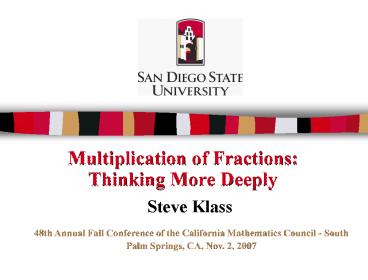Multiplication of Fractions: Thinking More Deeply - PowerPoint PPT Presentation
1 / 24
Title:
Multiplication of Fractions: Thinking More Deeply
Description:
Nadine is baking brownies. ... Which one best represents Nadine's brownie problem? 6. Reasoning About Multiplication ... Brownies ( is frosted, of the that part ... – PowerPoint PPT presentation
Number of Views:679
Avg rating:3.0/5.0
Title: Multiplication of Fractions: Thinking More Deeply
1
- Multiplication of Fractions Thinking More Deeply
Steve Klass
48th Annual Fall Conference of the California
Mathematics Council - South Palm Springs, CA,
Nov. 2, 2007
2
Todays Session
- Welcome and introductions
- What students need to know well before operations
with fractions - Contexts for multiplication of fractions
- Meanings for multiplication
- Models for multiplication of fractions
- Discussion
3
What Students Need to Know Well Before Operating
With Fractions
- Meaning of the denominator (number of equal-sized
pieces into which the whole has been cut) - Meaning of the numerator (how many pieces are
being considered) - The more pieces a whole is divided into, the
smaller the size of the pieces - Fractions arent just between zero and one, they
live between all the numbers on the number line - A fraction can have many different names
- Understand the meanings for operations for whole
numbers.
4
A Context for Fraction Multiplication
- Nadine is baking brownies. In her family, some
people like their brownies frosted without
walnuts, others like them frosted with walnuts,
and some just like them plain. - So Nadine frosts 3/4 of her batch of brownies
and puts walnuts on 2/3 of the frosted part. - How much of her batch of brownies has both
frosting and walnuts?
5
Multiplication of Fractions
- Consider
- and
- How do you think a child might solve each of
these? - Do both representations mean exactly the same
thing to children? - What kinds of reasoning and/or models might they
use to make sense of each of these problems? - Which one best represents Nadines brownie
problem?
6
Reasoning About Multiplication
- Whole number meanings - 2 U.S. textbook
conventions - 4 x 2 8
- Set - Four groups of two
- Area - Four rows of two columns
7
Reasoning About Multiplication
- 2 x 4 8
- Set - Two groups of four
- Area - Two rows of four columns
- When multiplying, each factor refers to something
different. One factor can tell how many groups
there are and the other, how many in each group.
The end result is the same product, but the
representations are quite different.
8
Reasoning About Multiplication
- Fraction meanings - U.S. conventions
- Set - Two-thirds of a group of three-fourths of
one whole - Area - Two-thirds of a row of three-fourths of
one column - Set - Three-fourths of a group of two-thirds of
one whole - Area - Three-fourths rows of two-thirds of one
column
9
Models for Reasoning About Multiplication
- Area/measurement models
- (e.g. fraction circles)
- Linear/measurement (e.g paper tape)
10
Materials for Modeling Multiplication of Fractions
- How could you use these materials to model
? - Paper tape
- Fraction circles
- You could also use
- Pattern blocks
- Fraction Bars / Fraction Strips
- Paper folding
11
Using a Linear Model With Multiplication
12
Using an Area Model with Fraction Circles for
Fraction Multiplication
- How could you use these materials to model
13
Materials for Modeling Multiplication of Fractions
- How could you use these materials to model
? - Paper tape
- Fraction circles
- You could also use
- Pattern blocks
- Fraction Bars / Fraction Strips
- Paper folding
14
Using a Linear Model With Multiplication
15
Using an Area Model with Fraction Circles for
Fraction Multiplication
- How could you use these materials to model
?
16
Mixed Number Multiplication
- Using a ruler and card, draw a rectangle that is
by - inches, and find the total number of
square inches. Find your answer first by
counting, then by multiplying. - Compare your answers, are they the same?
17
Mixed Number Multiplication
- Can you find out what each square is worth?
- What about partial squares?
18
Making Connections
19
Try it Yourself
- How can you use these materials to model
? - What contexts can you construct for these two
problems?
20
Other Contexts for Multiplication of Fractions
- Finding part of a part (a reason why
multiplication doesnt always make things
bigger) - Pizza (pepperoni on )
- Brownies ( is frosted, of the that part has
pecans) - Ribbon (you have yd , of the ribbon is used
to make a bow)
21
Thinking More Deeply About Multiplication of
Fractions
- Estimating and judging the reasonableness of
answers - Recognizing situations involving multiplication
of fractions - Considering, creating and representing contexts
where the multiplication of fractions occurs - Making careful number choices
22
Questions/Discussion
23
Contact Ussklass_at_projects.sdsu.eduhttp//pdc.s
dsu.edu
24
(No Transcript)































